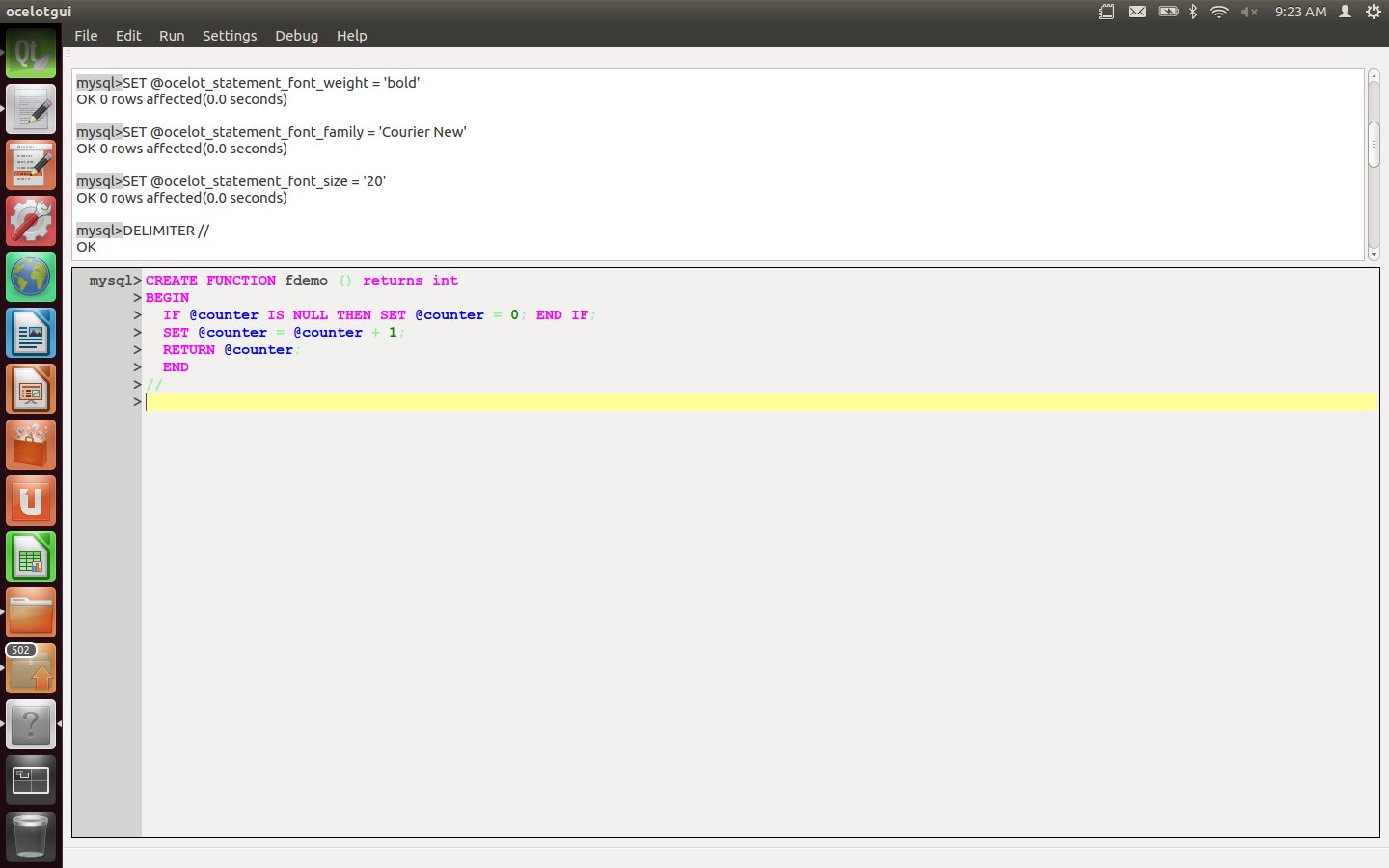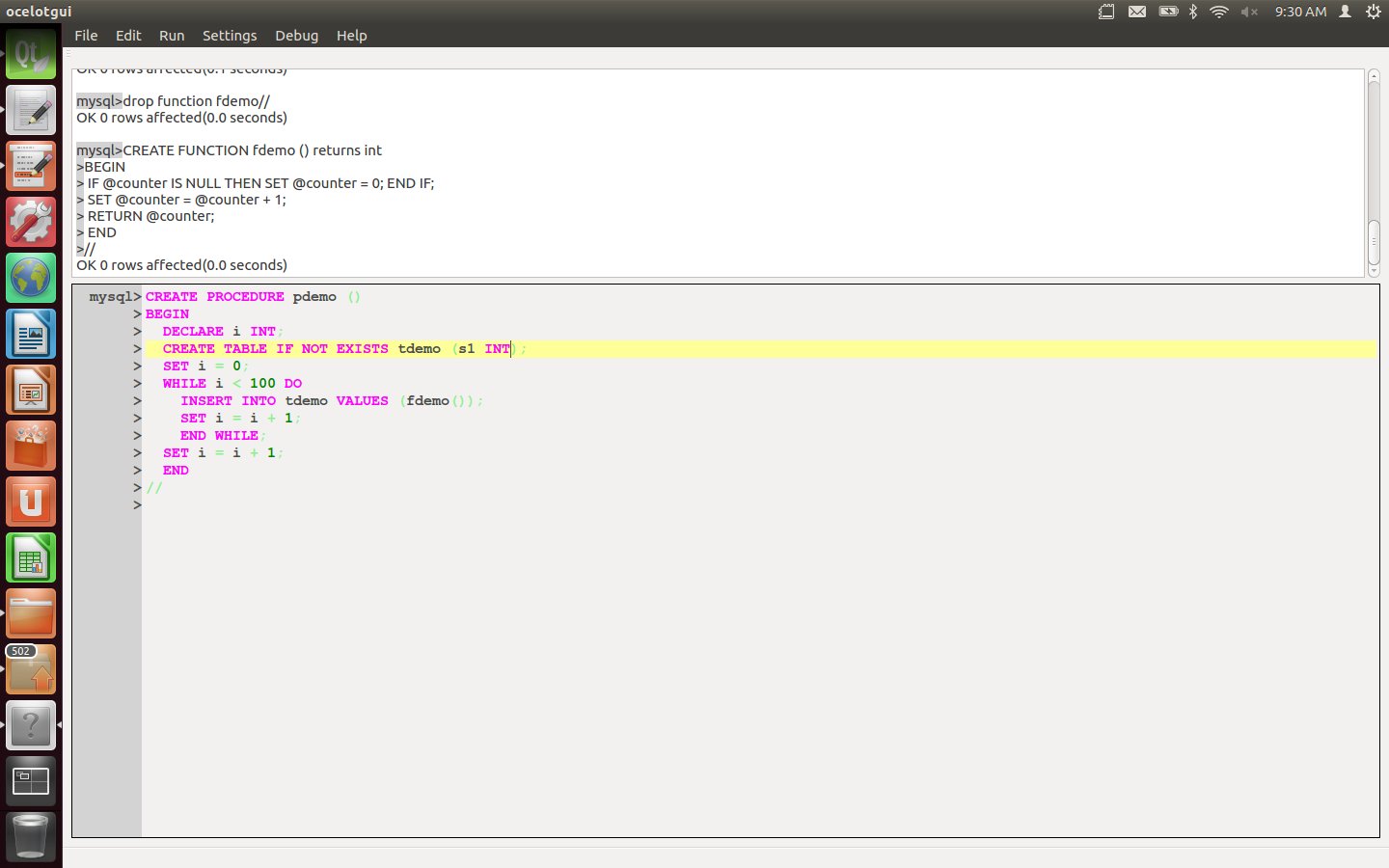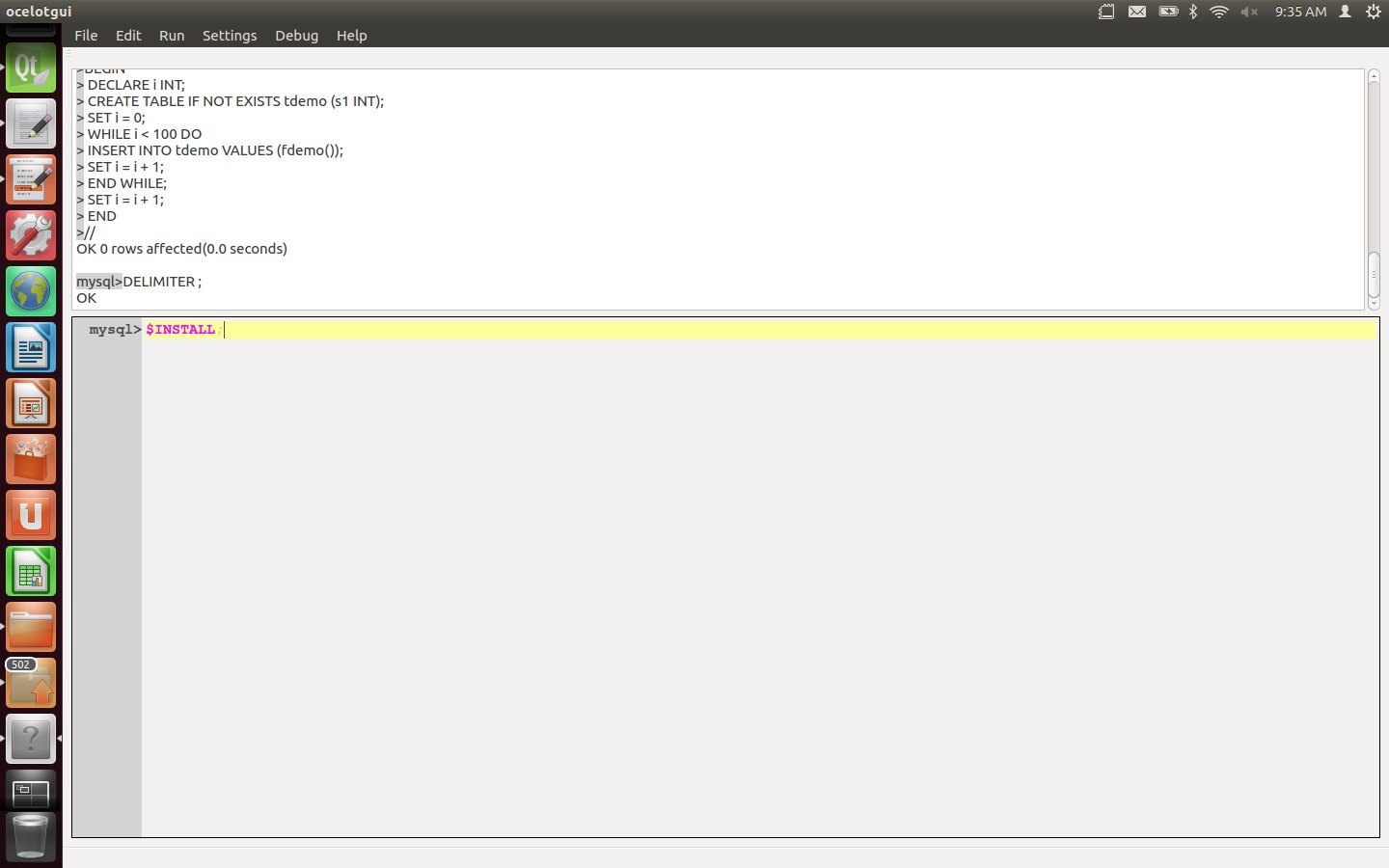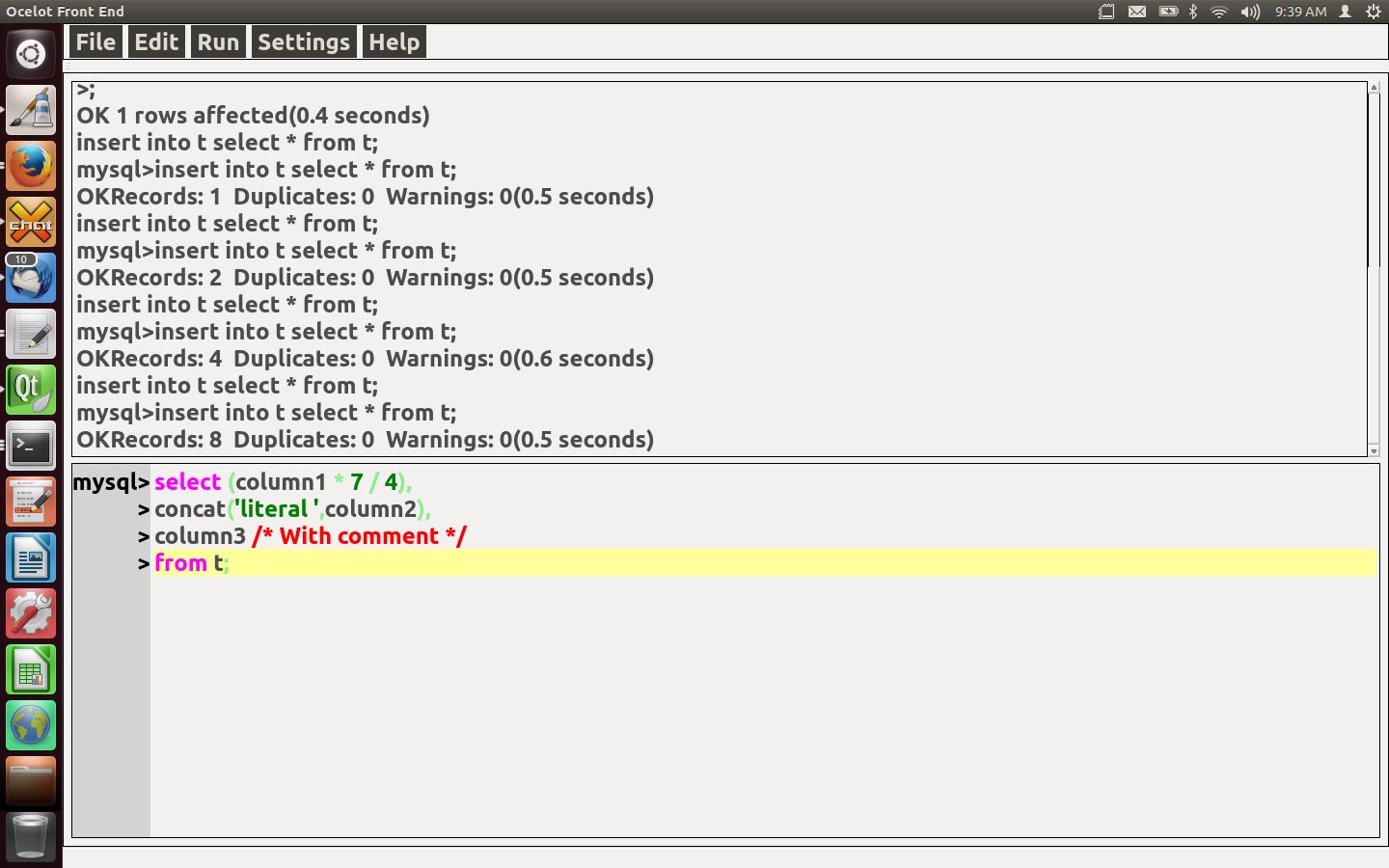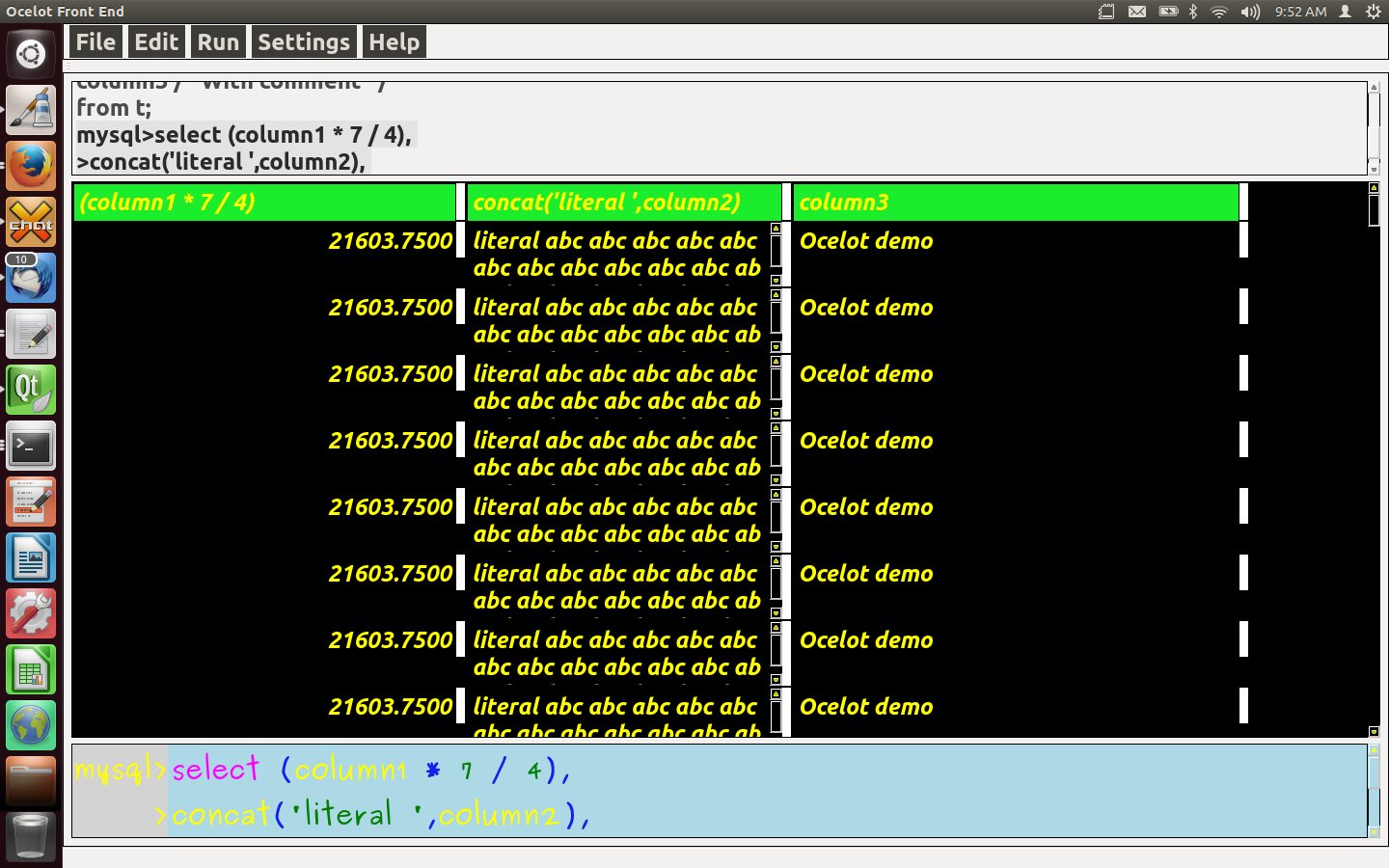Category: MySQL / MariaDB
Generated columns in MariaDB and MySQL
It has been seven years since the last time I blogged about generated columns, and a lot has happened — now both MariaDB and MySQL support them. So it’s time to look again, see how well they’re doing, and compare to the SQL standard’s Optional feature T175 Generated columns.
This is not an introductory description or an explanation why you’d want to use generated columns rather than (say) triggers and views. For that, I’d recommend the relevant manuals or the blog posts by Alexander Rubin and Anders Karlsson.
The Generation Clause
Standard MariaDB 10.1 MySQL 5.7
--------- ------------ ---------
[data type] data_type data type
GENERATED ALWAYS [GENERATED ALWAYS] [GENERATED ALWAYS]
AS AS AS
(expression) (expression) (expression)
[VIRTUAL | PERSISTENT] [VIRTUAL | STORED]
[constraints] [constraints] [constraints]
[COMMENT 'string'] [COMMENT 'string']
The above side-by-side BNFs show the standard syntax and the syntax that MariaDB and MySQL actually allow at the time I’m writing this. The MariaDB manual says incorrectly that either VIRTUAL or PERSISTENT is mandatory. The MySQL manual suggests incorrectly that the clause order is fixed, and has a typo: there should be two “]]”s after “STORED”.
The first important deviation from standard SQL is that “data type” is not an optional clause in either MariaDB or MySQL. The data type can be figured out from the type of the expression, after all.
The second important deviation is that [GENERATED ALWAYS] is optional and there’s a way to say whether the column is virtual (column value is generated when it’s accessed) or persistent/stored (column value is generated when it’s set, and kept in the database). I call this a single deviation because it’s got a single backgrounder: compatibility with Microsoft SQL Server. In fact the original title of the worklog task (WL#411) was “Computed virtual columns as MS [i.e. Microsoft] SQL server has”. We changed it to “Generated columns”, but the perfume of Microsoftness lingers, and you’ll see traces in the vocabulary too. For example, MariaDB has an error message: “”HY000 A computed column cannot be based on a computed column”.
So the tip sheet is: for the sake of compatibility with the standard rather than with Microsoft, always say GENERATED ALWAYS, and call it a “generated” column not a “computed” column. It’s okay to say VIRTUAL, though, because Oracle does.
Restrictions
In standard SQL these restrictions apply:
“Every column reference contained in [the generation expression) shall reference a base column of [the same table].”
In other words, a generated column cannot be based on another generated column. MariaDB adheres to this, but MySQL, as a harmless extension, allows
CREATE TABLE t (a INT, b INT GENERATED ALWAYS AS (a), c INT GENERATED ALWAYS AS (b));
“[The generation expression] shall be deterministic.”
This is pretty reasonable, and both MariaDB and MySQL comply.
“[The generation expression] shall not contain a routine invocation whose subject routine possibly reads SQL-data.”
This is reasonable too, but MariaDB and MySQL go much further — they forbid every user-defined function, even if it’s declared that it’s deterministic and reads no SQL data.
“[The generation expression] shall not contain a query expression”.
In other words, GENERATED ALWAYS AS (SELECT …)” is a no-no. Again, reasonable, and I doubt it will occur to anyone to try.
Differences between MariaDB and MySQL
We’re actually looking at two different implementations — MariaDB’s generated columns come ultimately from a user contribution by Andrey Zhakov, while MySQL’s generated columns are younger and are more of an in-house development. (Update added later: Mr Zhakov deserves credit for the MySQL development too, see the comments.) Things worth noticing are:
* the PERSISTENT versus STORED syntax detail, mentioned earlier,
* GENERATED is a reserved word in MySQL but not in MariaDB,
* MariaDB has some restrictions about foreign keys that MySQL doesn’t have.
MySQL lacks some restrictions about foreign keys, eh? That could lead to interesting results. I tried this sequence of statements:
CREATE TABLE t1 (s1 INT PRIMARY KEY);
CREATE TABLE t2 (s1 INT,
s2 INT AS (s1) STORED,
FOREIGN KEY (s1) REFERENCES t1 (s1)
ON UPDATE CASCADE);
INSERT INTO t1 VALUES (1);
INSERT INTO t2 VALUES (1, DEFAULT);
UPDATE t1 SET s1 = 2;
SELECT * FROM t1;
SELECT * FROM t2;
And the results from the two SELECTs looked like this:
mysql> SELECT * FROM t1; +----+ | s1 | +----+ | 2 | +----+ 1 row in set (0.00 sec) mysql> SELECT * FROM t2; +------+------+ | s1 | s2 | +------+------+ | 2 | 1 | +------+------+ 1 row in set (0.00 sec)
If you’re thinking “whoa, that shouldn’t be right”, then I’m sure you’ll understand why MariaDB doesn’t allow this trick.
Metadata
In the standard there are two relevant INFORMAIION_SCHEMA columns: IS_GENERATED and GENERATION_EXPRESSION. In MySQL all we get is a value in the EXTRA column: “VIRTUAL GENERATED”. In MariaDB also we get a value in the EXTRA column: “VIRTUAL”.
I’d say that both implementations are deficient here — you can’t even see what the “(expression)” was.
Hurray For Everybody
Both MariaDB and MySQL have slight flaws in their implementations of generated columns, but my complaints here shouldn’t cause worry. Both are robust, as I found out by wasting time looking for bugs. This feature can be used.
What about us?
In my last blog post I may have been over-confident when I predicted ocelotgui (our GUI for MariaDB and MySQL) would allow multiple connections and go beta this month. We will have something that, I hope, will be far more exciting.
Send messages between sessions on MySQL or MariaDB
Suppose you want to send a message from one SQL session to one or more other sessions, like “Hey, session#13, here is the latest figure for your calculation, please acknowledge”. I’ll say what Oracle and EnterpriseDB and DB2 do, then rate the various ways to implement something similar in MySQL and MariaDB, and finish with a demo of the procedure that we use, which is available as part of an open-source package.
The syntax was established by Oracle, with EnterpriseDB and IBM following suit. The details are in the Oracle 12c manual and the DB2 9.7 manual. The oversimplification is this:
DBMS_PIPE.PACK_MESSAGE('message');
SET status = DBMS_PIPE.SEND_MESSAGE('channel#1');
SET status = DBMS_PIPE.RECEIVE_MESSAGE('channel#1');
DBMS_PIPE.UNPACK_MESSAGE(target_variable);
The idea is that PACK_MESSAGE prepares the message, SEND_MESSAGE ships the message on a channel, RECEIVE_MESSAGE receives something on a channel, and UNPACK_MESSAGE puts a received message in a variable. The whole package is called DBMS_PIPE because “pipe” is a common word when the topic is Inter-process communication.
MySQL and MariaDB don’t have DBMS_PIPE, but it’s possible to write it as an SQL stored procedure. I did, while working for Hewlett-Packard. Before saying “here it is”, I want to share the agony that we endured when deciding what, at the lowest level, would be the best mechanism.
The criteria are:
size -- how many bits can a message contain? isolation -- how many conversations can take place simultaneously? privilege -- how specific is the authorization, if any? is eavesdropping easy? danger -- what are the chances of fouling up some other process? reliability -- can messages be delayed or destroyed? utility -- can it be used at any time regardless of what's gone before?
There is no “overhead” criterion because messaging should be rare.
These are the 5 candidate mechanisms.
1. Tables.
Session#1 INSERTs to a table, Session#2 SELECTs from the table.
Rating: size=good, isolation=good, privilege=good, danger=low, reliability=good.
But utility=terrible. First: with some storage engines you have to COMMIT in order to send and this might not be a time that you want to COMMIT. Second and more important: there’s a bit of fine print in the MySQL Reference Manual:
A stored function acquires table locks before executing, to avoid inconsistency in the binary log due to mismatch of the order in which statements execute and when they appear in the log.
Think about it. It means that you can’t read a message that’s sent by a function while the function is running. And you can’t work around that by writing the messaging code in a stored procedure — there’s no guarantee that the stored procedure won’t be called from a function.
2. Files.
Session#1 uses SELECT … INTO OUTFILE. Session#2 says LOAD_FILE.
(We don’t consider LOAD DATA because it won’t work in stored procedures.)
Rating: size=good, isolation=good, privilege=good, utility=good.
But danger=high, reliability=bad. The problem is that you can’t overwrite a file, so the messages would pile up indefinitely.
3. information_schema.processlist.
Session#1 says SELECT SLEEP(0.5),’message’. Session#2 says SELECT from information_schema.processlist.
Rating: size=bad, isolation=bad, privilege=good, danger=low, utility=bad.
This is okay for short messages if you’re not worried about eavesdropping. But notice that the message can only be a literal, like ‘message’. It cannot always be a variable, because then it’s dynamic SQL, and dynamic SQL is illegal in functions, and now you’ve got the same problem as with mechanism number 1.
4. GET_LOCK.
Session#1 says GET_LOCK(). Session#2 says IS_USED_LOCK().
Rating: size=bad, isolation=good, privilege=good, danger=low, utility=good.
Technically reliability=low because the message disappears when the server goes down, but in many situations that would actually be a good thing. The rating “size=bad” is easy to understand: effectively there’s only one bit of information (yes/no) that Session#2 is getting by checking IS_USED_LOCK(). However, one-bit signals are great for lots of applications so this would still fit in a toolkit if it weren’t for The Great GET_LOCK Showstopper. Namely, you can only have one GET_LOCK at a time.
Now for the good news. Multiple GET_LOCK invocations are on their way. The person to thank (and I say “thank” because this was a contribution done to the whole community) is Konstantin Osipov, who wrote a patch and a blog post — “MySQL: multiple user level locks per connection”. As I understand matters, this was a basis for the code that is coming in a future MySQL version and is now in the MySQL 5.7.5 manual. Konstantin Osipov, by the way, nowadays writes for the Tarantool NoSQL DBMS and Lua application server, to which I am pleased to contribute in small ways.
5. System variables.
Session#1 says SET @@variable_name = ‘message’. Session#2 says target = @@variable_name.
Rating: size=bad, isolation=good, privilege=good, danger=high, utility=good.
The system variable must be a string, must be dynamically writable, and must not change the server’s behaviour if you write a bad value. Only one item does all that: @@init_connect. It’s actually easy to ensure that changes to @@init_connect won’t affect its official purpose — just put the message /* inside a comment */. However, I still rate it as danger=high because anybody could overwrite the message inadvertently.
And the winner, as far as we’re concerned, is … #5 System variables. Remember, Ocelot is supplying a debugger for MySQL/MariaDB routines. It would be a pretty poor debugger that used a message mechanism that wouldn’t work with functions, so mechanism#1 and mechanism#3 are out. The GET_LOCK of mechanism#4 is in fact used by a different debugger, but in my opinion that means it’s hard to have two debugger sessions on the same server, or to run without pausing after every statement. So our implementation involves setting @@init_connect.
If you want to see our implementation, here is how (on Linux).
Download, install, and start ocelotgui. The instructions are in the
README.md file at https://github.com/ocelot-inc/ocelotgui (just scroll past the list of files). Connect to a MySQL/MariaDB server as a user with privileges to create databases and tables, and execute routines. Then type in, on the statement widget
$INSTALL
After this, you actually won’t need ocelotgui any more. So, although I think the real “demo” would be to use the debugger now that you’ve installed it, I’ll show how to use pipes with the mysql client instead.
Start a shell. Start mysql. You need the SUPER privilege, and the EXECUTE privilege for routines in the xxxmdbug database. Send a message.
MariaDB [(none)]> call xxxmdbug.dbms_pipe_send('channel#1','message');
Query OK, 0 rows affected (0.00 sec)
Start a second shell. Receive a message.
MariaDB [(none)]> call xxxmdbug.dbms_pipe_receive
-> ('channel#1',1,@message_part_1,@message_part_2);
Query OK, 0 rows affected (0.00 sec)
MariaDB [(none)]> select @message_part_1;
+-----------------+
| @message_part_1 |
+-----------------+
| message |
+-----------------+
1 row in set (0.00 sec)
You can see how it’s implemented by saying
SELECT * FROM information_schema.routines WHERE routine_schema = 'xxxmdbug' AND routine_name like 'dbms_pipe_%';
The dbms_pipe_send and dbms_pipe_receive routines are GPL and copyrighted by Hewlett-Packard.
I might not moderate comments on this blog while on vacation. Tomorrow I leave for Reykjavik, Amsterdam and London.
MYSQL_HISTFILE and .mysql_history
The MySQL manual says:
“mysql Logging
On Unix, the mysql client logs statements executed interactively to a history file. By default, this file is named .mysql_history in your home directory. To specify a different file, set the value of the MYSQL_HISTFILE environment variable.”
The trouble with that is: it doesn’t tell you what you don’t need to know. So I’ll tell you.
Heritage
The history-file concept that MySQL and MariaDB are following is indeed “on Unix” and specifically is like the GNU History Library. There is a dependence on external libraries, Readline or EditLine/libedit, depending on the licence. The similarity to (say) the Bash shell history is clear when one compares some names and some actions.
| Thing | Bash | MySQL |
|---|---|---|
| Default file name | $HOME/.bash_history | $HOME/.mysql_history |
| Environment variable for name | HISTFILE | MYSQL_HISTFILE |
| Environment variable for ignoring | HISTIGNORE | MYSQL_HISTIGNORE |
This explains why the history file is hidden, why the facility doesn’t work on Windows, and why there’s no orthogonality (that is, one can set an environment variable but one cannot set a configuration-file or command-line parameter).
Is it really a log?
The manual says .mysql_history is a log, but that’s a bit misleading, since it’s not much like the “logs” that the server produces (the transaction log, the slow query log, etc.). There are no timestamps; there is a large class of SQL statements that are ignored such as ones that come via file input; there is no way to know which statements succeeded and which ones ended with errors.
So the only thing .mysql_history is truly good for is making some edits easier. If you like to say “repeat last statements”, or some sophisticated variant that requires knowing what earlier statements were, then the mysql client — actually, the Readline or EditLine library — needs the history for that.
Also it’s occasionally useful for answering questions like “How did I get myself into this mess?” when odd things start to happen, and especially so when you have to write a bug report and your friendly MySQL or SkySQL or Percona support worker enquires: “Could you please show us the things you were doing just before the, er, anomaly occurred.” A tee file would be better, but sometimes a histfile might do.
Format
Not all versions of the mysql client will write the .mysql_history file in the same way. That is why sometimes you will see “X Y” if you print the file, but sometimes you will see “X\040Y”. Of course 040 is the octal for the ASCII for the space character, but this has led to bug reports such as Bug#14634386 – “History written by Libedit is not readable by Readline” and Bug#16633124 – Compatibility issue with mysql history (“\040” instead of space). These are Oracle internal bug numbers, so don’t bother trying to find them on bugs.mysql.com. They’re unimportant bugs, since they should not cause problems for editing.
A more severe matter is that multi-line statements are logged twice. First there is a record of each line. Then there is a record of the statement as a whole.
Stopping
Although disk space is cheap, people do worry sometimes when they realize their computer might be writing secret stuff in a file that burglars could see. The easiest prevention is to start the mysql client with –batch or an option that implies –batch. However, those options all do something else, as well as stopping writing to .mysql_history, so they’re not “well targeted” solutions.
There’s a recommendation to set the MYSQL_HISTFILE environment variable to say “/dev/null”, or to link the .mysql_history file to /dev/null. Loosely one might think: oh, statements are being sent to /dev/null and therefore they won’t get saved. More accurately, they might not be sent anywhere at all, as one can see from these snippets of mysql.cc code (Copyright (c) 2000, 2014, Oracle and/or its affiliates):
if (my_readlink(link_name, histfile, 0) == 0 &&
strncmp(link_name, "/dev/null", 10) == 0)
{
my_free(histfile);
histfile= 0;
}
...
if (histfile && strncmp(histfile, "/dev/null", 10) == 0)
histfile= NULL;
Limiting
Despite the similarities to Bash, there is no MYSQL_HISTSIZE environment variable to be like Bash’s HISTSIZE. With some unreliable fiddling, one can try to tell the underlying library what the maximum history size should be, that is, how many lines are allowed in the history file before starting to discard. For example, instead of saying “/usr/bin/mysql”, say
rlwrap -a --histsize=5 /usr/bin/mysql
Usually this particular trick is best avoided because of its side effects.
MYSQL_HISTIGNORE
In MySQL’s mysql, there’s a newish environment variable:
export MYSQL_HISTIGNORE=pattern
It’s not in my copy of MariaDB’s mysql, but I suppose we can expect it soon. The idea is: if a statement matches the pattern, then it doesn’t get saved in the history file. But there are some flaws …
- There are only two wildcards for the pattern: “?” meaning “one occurrence of any character”, and “*” meaning “zero or more occurrences of any character”. There is no regular-expression variation, and the choice is un-SQL-ish (in SQL one would use _ and % not ? and *).
- A certain pattern is always in effect so that passwords won’t be saved. A fine default, but it’s regrettable that there’s no way to remove it.
- It appears to be impossible to escape certain characters. For example, if I wanted the pattern to include a colon, I couldn’t say “export MYSQL_HISTIGNORE=a\:b”.
ocelotgui
The objective of Ocelot Computer Services Inc. is that the ocelotgui program will do anything that the mysql client can do, and one can dream that there are ways to do even more (porting to Windows, recognizing history size, matching more expressions, etc.) along with the advantages that a GUI automatically has over a command-line editor. But at the moment we don’t have a histfile, we only support tee. I think that’s the last big feature that ocelotgui needs before we call it ‘feature complete’, which is why I’ve been looking at .mysql_history details.
The latest ocelotgui release is 0.6.0, source and binaries are on github.com/ocelot-inc/ocelotgui.
Connecting to MySQL or MariaDB with sockets on Linux
The MySQL manual says
–socket=file_name, -S file_name … On Unix, the name of the Unix socket file to use, for connections made using a named pipe to a local server.
The default Unix socket file name is /tmp/mysql.sock.
which might surprise folks who’ve had to contend with the error message
“Can’t connect to local MySQL server through socket ‘[something-other-than-/tmp/mysql.sock]'”.
I’ll try to explain here why the name is often something quite different, how to know what the MySQL server is really listening for, what the fixes are for either users or application developers, and why it still matters.
Why the name is not always /tmp/mysql.sock
First, the Linux Foundation publishes a document “Filesystem Hierarchy Standard”. Version 2.3 says in the section about the /var/run directory: “Programs that maintain transient UNIX-domain sockets must place them in this directory.” Unfortunately Version 3 says something a bit different
in the section about the /run directory: “System programs that maintain transient UNIX-domain sockets must place them in this directory or an appropriate subdirectory as outlined above.” But version 3 also says: “In general, programs may continue to use /var/run to fulfill the requirements set out for /run for the purposes of backwards compatibility.” so /var/run is still standard.
Second, there’s a bit of fine print tucked away in an appendix of the MySQL manual: “For some distribution formats, the directory might be different, such as /var/lib/mysql for RPMs.” That’s a vague way of saying it’s determined at source-installation time by -DINSTALL_LAYOUT={STANDALONE|RPM|SVR4|DEB} which in effect causes this:
SET(INSTALL_UNIX_ADDRDIR_STANDALONE "/tmp/mysql.sock") SET(INSTALL_UNIX_ADDRDIR_RPM "/var/lib/mysql/mysql.sock") SET(INSTALL_UNIX_ADDRDIR_DEB "/var/run/mysqld/mysqld.sock") SET(INSTALL_UNIX_ADDRDIR_SVR "/tmp/mysql.sock")
but anybody can override that by setting MYSQL_UNIX_ADDR to something else.
And so different machines have different defaults. The following comes from notes I made long ago so may not be the latest information:
Non-Linux e.g. FreeBSD or Solaris: /tmp/mysql.sock Debian-based e.g. Ubuntu, and archlinux: /var/run/mysqld/mysqld.sock SUSE (after v11.2): /var/run/mysql/mysql.sock Red Hat, and SUSE (before v11.2): /var/lib/mysql/mysql.sock archlinux (very old versions): /tmp/mysqld.sock
Sometimes you can find out what the real default on your machine was,
by typing mysql_config –socket.
Finding what the server is really listening for
If you’re not the one who started the server, or the starting has disappeared in the mists of memory, there are various flawed ways to find what socket
it’s really opened.
Possible Method #1: netstat -lpn | grep mysqld
Example:
$ netstat -lpn | grep mysqld (Not all processes could be identified, non-owned process info will not be shown, you would have to be root to see it all.) tcp6 0 0 :::3306 :::* LISTEN 4436/mysqld unix 2 [ ACC ] STREAM LISTENING 101567 4436/mysqld ./mysql_sock
… This method’s flaw is that, as the warning says, you won’t see everything unless you’re root. Also the “grep mysqld” filtering means it’s assumed the server’s name is mysqld.
Possible Method #2: find directory-list -name “mysql*.sock”
Example:
$ find /tmp /var/lib/mysql /var/run/mysqld -name "mysql*.sock" find: 'var/lib/mysql': Permission denied /var/run/mysqld/mysqld.sock
… This method’s flaw is that you have to guess in advance what directories the socket might be on.
Possible Method #3: ask via TCP
Example:
mysql -h 127.0.0.1 -e "select @@socket" +-----------------------------+ | /var/run/mysqld/mysqld.sock | +-----------------------------+
… This method’s flaw is in the assumption that the port is the default (3306), that the local host is accessible (I think it’s theoretically possible that it won’t be), and that everyone has the privilege to access MySQL this way.
Possible Method #4: look at the running process
Example (after finding with ps -A that mysqld process ID = 3938):
$ ps -fp 3938 UID PID PPID C STIME TTY TIME CMD 1000 3938 18201 0 09:58 pts/2 00:00:00 bin/mysqld --socket=./sock
… This method’s flaw is that it only works if –socket was specified explicitly on a mysqld command line, overriding the default configuration.
What a user can do
Once you know that the server is listening on socket X, you can redirect with ln, for example
ln -s /var/run/mysqld/mysqld.sock /tmp/mysql.sock
… The flaw this time is that it’s trying to solve a MySQL/MariaDB problem with a Linux workaround. The only reason that I mention it is that I’ve seen it recommended on Internet forums, so I guess some people see advantages here, which I don’t.
A better answer, then, would be: tell the client program what the socket is. On a client that follows the MySQL guidelines (such as the mysql client itself, or ocelotgui), this would mean setting the MYSQL_UNIX_PORT environment variable, or starting with –socket=X on the command line, or changing one of the configuration files such as ~/.my.cnf to add the line socket = X. Beware that the socket location might also be stored in other places, such as /etc/mysql/debian.cnf or php.ini.
What a client program should do
People who write client programs shouldn’t pass this socket hassle on to the user, if they don’t have to.
The mysql client tries to make things easier by, in effect, hard-coding a socket name so it’s the same as what the server got installed with. That’s a good try. My only criticism is that mysql –help will say that the socket parameter has “(No default value)” when, in a sense, it does.
I’ve been told that another client-GUI product tries to make things easier by automatically going with TCP. It’s difficult to criticize this — I’ve always thought that MySQL made trouble for itself by deciding that even when a user says “host=localhost” we should ignore the usual implication that the user is trying to use TCP and try to find a socket anyway — but here at Ocelot we try to behave the way the mysql client behaves, flawed or not.
So ocelotgui will try to make things easier by hard-coding the most likely paths. That is, if the user doesn’t specify a socket but the host is either default or ‘localhost’, then ocelotgui will try to connect via /tmp/mysql.sock, and if that fails then /var/lib/mysql/mysql.sock, and if that fails then /var/run/mysqld/mysqld.sock. That’s just the plan; currently ocelotgui isn’t doing it.
Is it worth caring about?
Couldn’t the Gordian socket be cut by saying protocol=TCP? What’s the point of finding the socket, anyway?
The answer usually is performance. The transfer rate with sockets is faster than with TCP because why do I need to worry about protocol when I’m talking to myself? I haven’t done a benchmark myself but Brandon D. Northcutt did and it does appear that sockets are worth the trouble if huge quantities of data are coming through.
However, really the TCP-versus-socket difference is a Linux problem, so why isn’t it being solved by the Linux crowd rather than the MySQL or MariaDB crowds? Well, unsurprisingly, that question has been asked before. So there is a fix, or more precisely there is a Google patch, which turns a TCP/IP connection into a socket connection if the target is localhost. There was an article about it on lwn.net in 2012. What happened after that, I don’t know.
By the way
The current state of ocelotgui (our open-source GUI client for MySQL and MariaDB) is still alpha, but it’s stable and good-looking now. Some screenshots are here. The latest release is 0.7, here.
The ocelotgui debugger
I have merged a debugger for MySQL/MariaDB stored procedures and functions into our GUI client and posted the source and binaries on github. It allows breakpoint, clear, continue, next, skip, step, tbreakpoint, and variable displays. Features which are rare or missing in other debuggers include:
its current platform is Linux;
it allows breakpoints on functions which are invoked within SQL statements;
it never changes existing stored procedures or functions;
it is integrated with a general GUI client;
it allows commands like gdb and allows menu items / shortcut keys like ddd;
it is available on github as C++ source with GPL licence.
It’s alpha and it’s fragile but it works. Here is a demo.
Start the client and connect to a running server, as root. Actually the required privileges are merely for creation of certain objects and SUPER, but I’m making this simple.
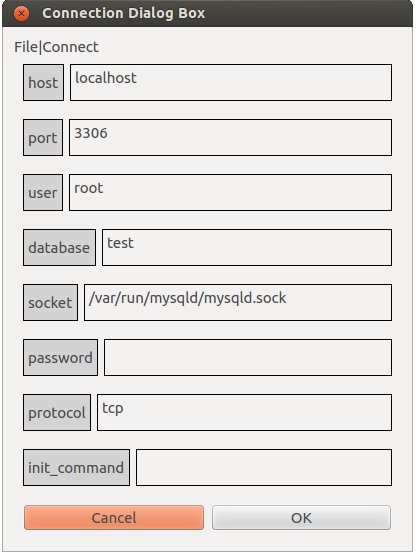
Type the statement: DELIMITER // (For all typed-in instructions, execute by typing carriage-return after the delimiter or by clicking Run|Execute.)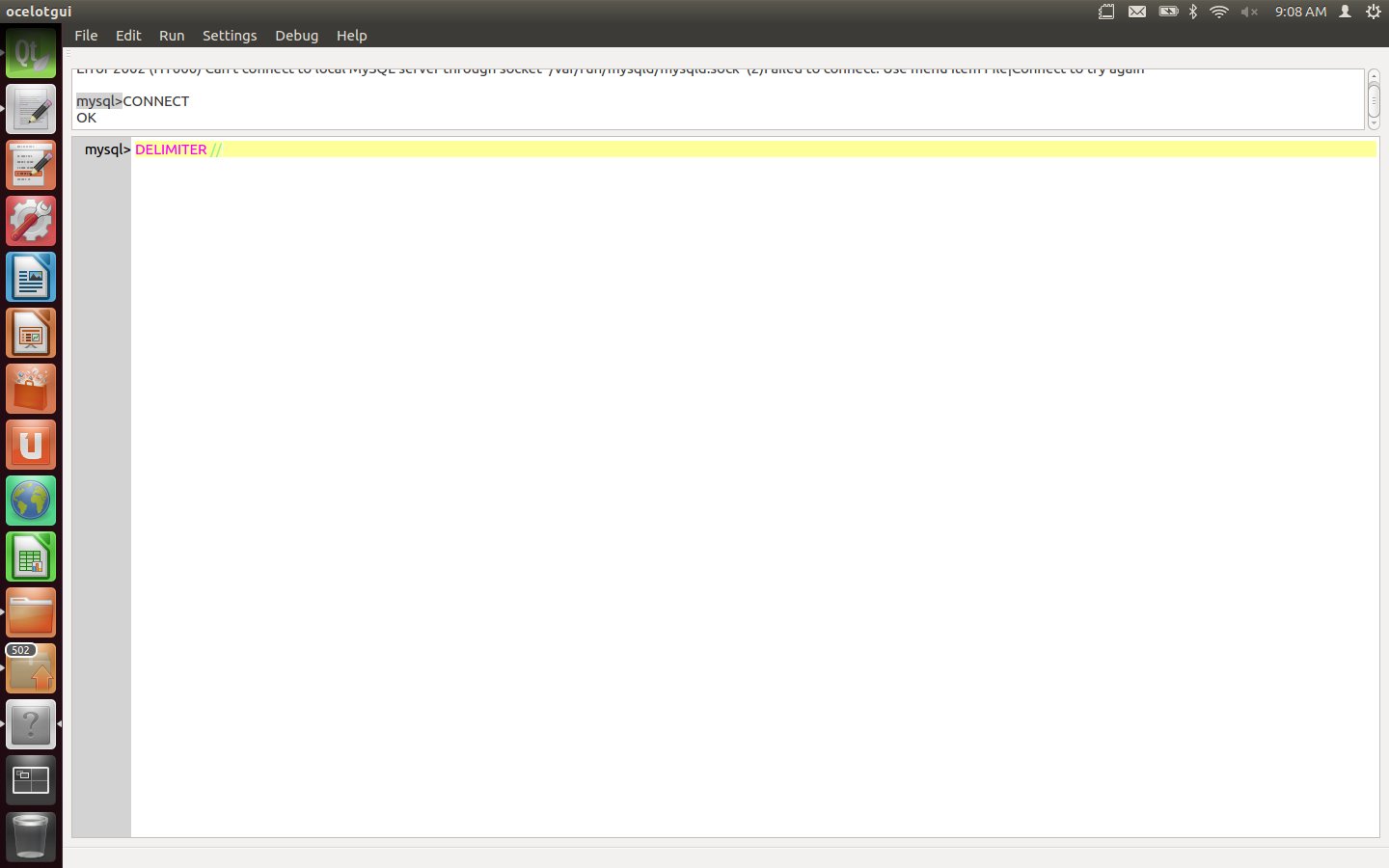
Create a function fdemo which updates and returns a counter.
CREATE FUNCTION fdemo () RETURNS INT
BEGIN
IF @counter IS NULL THEN SET @counter = 0; END IF;
SET @counter = @counter + 1;
RETURN @counter;
END
//
Create a procedure pdemo which contains a loop of “INSERT INTO tdemo VALUES (fdemo())” statements.
CREATE PROCEDURE pdemo ()
BEGIN
DECLARE i INT;
CREATE TABLE IF NOT EXISTS tdemo (s1 INT);
SET i = 0;
WHILE i < 100 DO
INSERT INTO tdemo VALUES (fdemo());
SET i = i + 1;
END WHILE;
SET i = i + 1;
END
//
Type the statement: DELIMITER ;
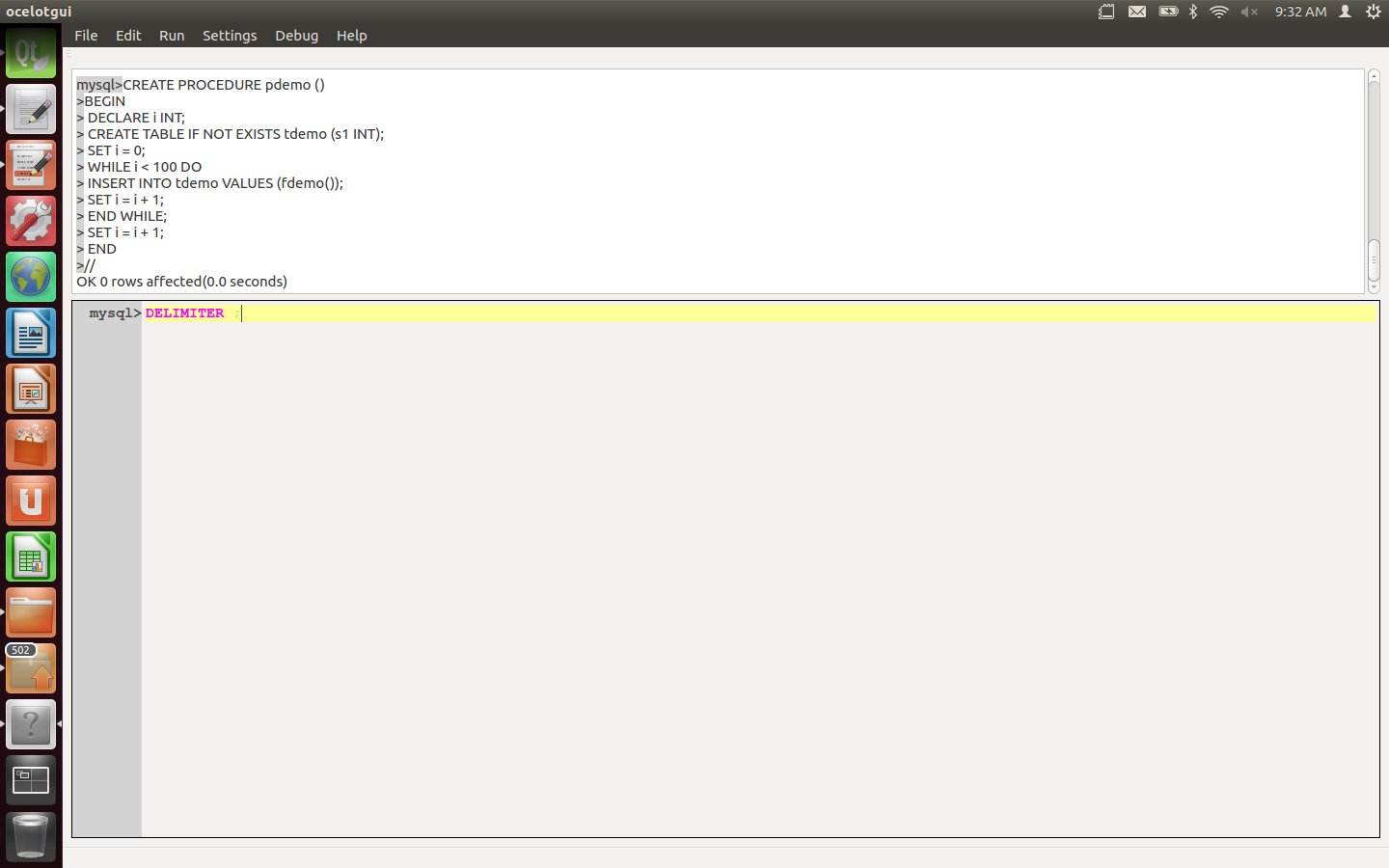
Type the statement: $setup fdemo, pdemo;

Type the statement: $debug pdemo;
After this statement is executed a tabbed widget appears. The first line of pdemo is highlighted. There is always a breakpoint before the first line.
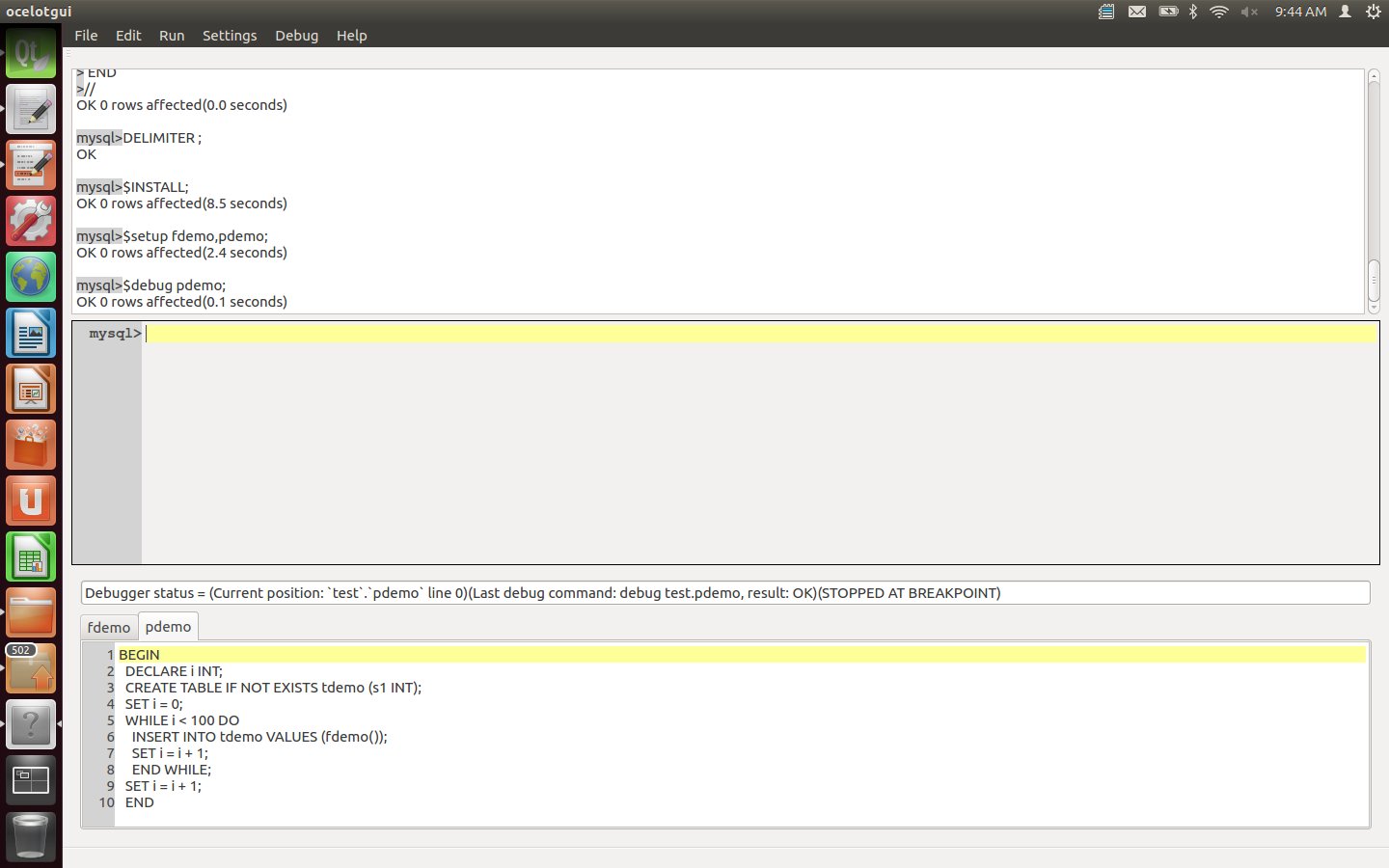
Click on the Debug menu to see what options are available. Debugger instructions may be done via the menu, via Alt keys, or via command-line statements. For example to enter a Next instruction one may now click Debug|Next, or type Alt+3, or type the statement: "$next;".

Enter a Next instruction repeatedly, watching how the highlighted line changes, until the INSERT line is highlighted.
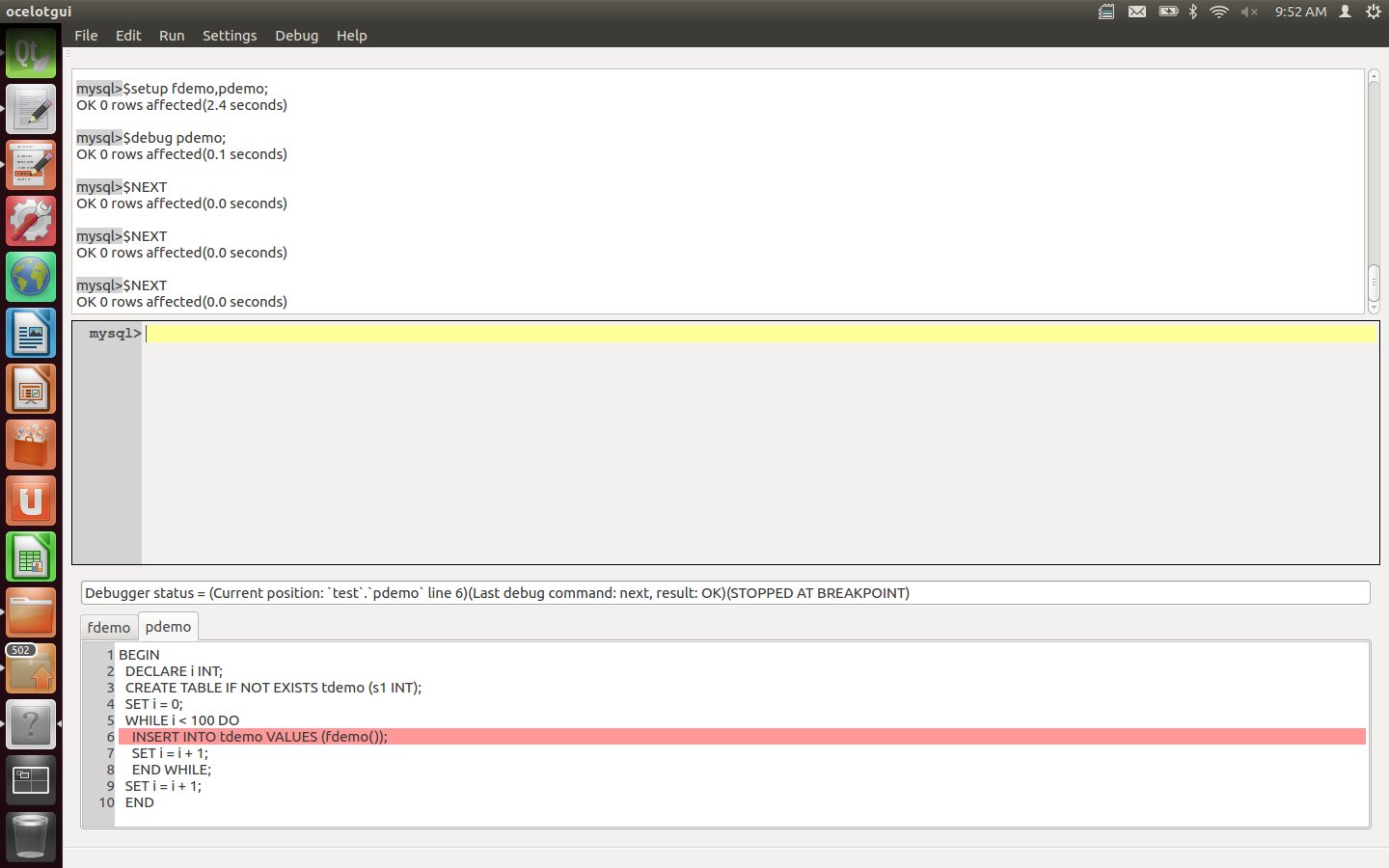
Enter a Step instruction. After this is executed, the function now comes into the foreground.
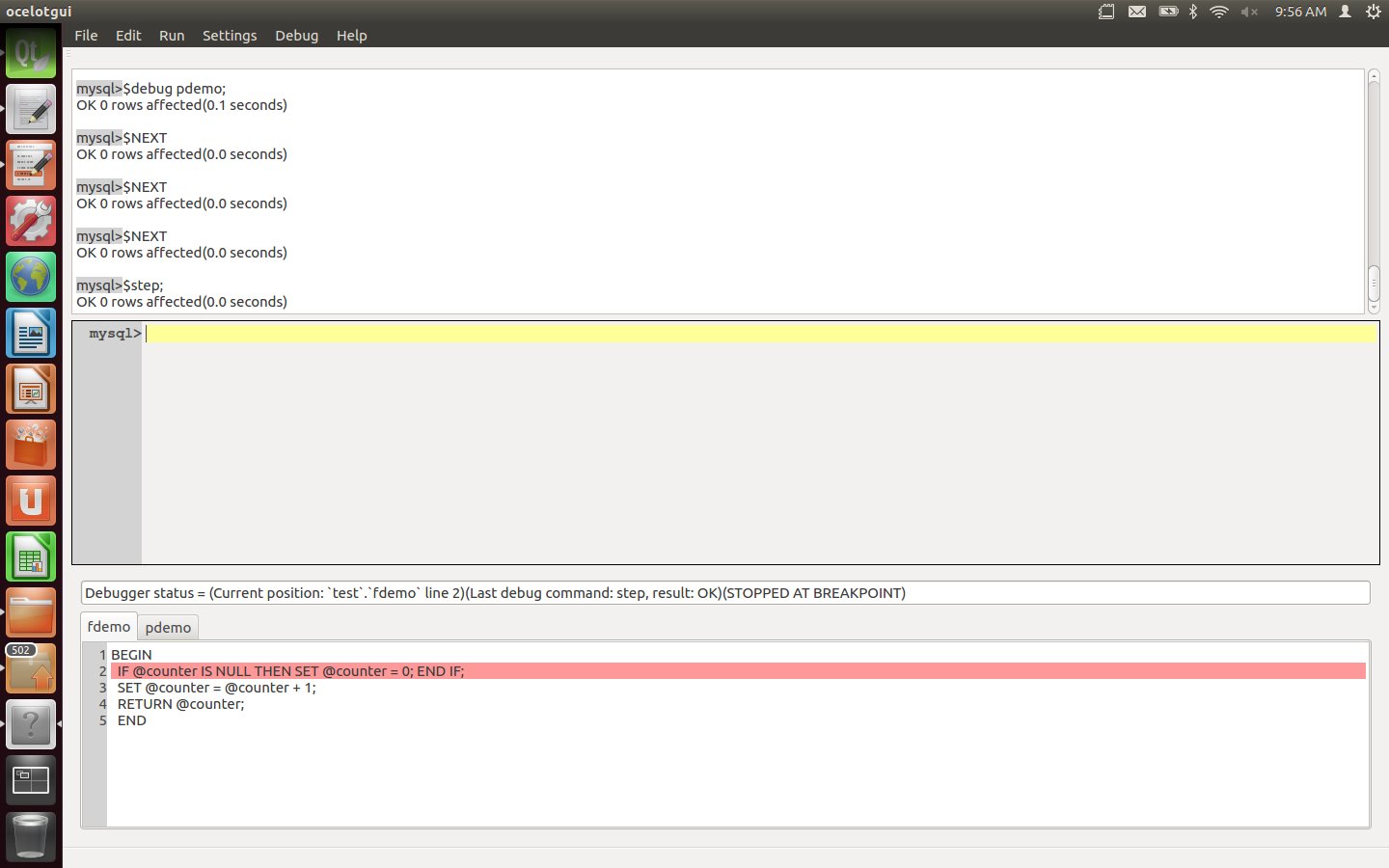
Enter three more Step (or Next) instructions. After these are executed, the procedure now is in the foreground again.
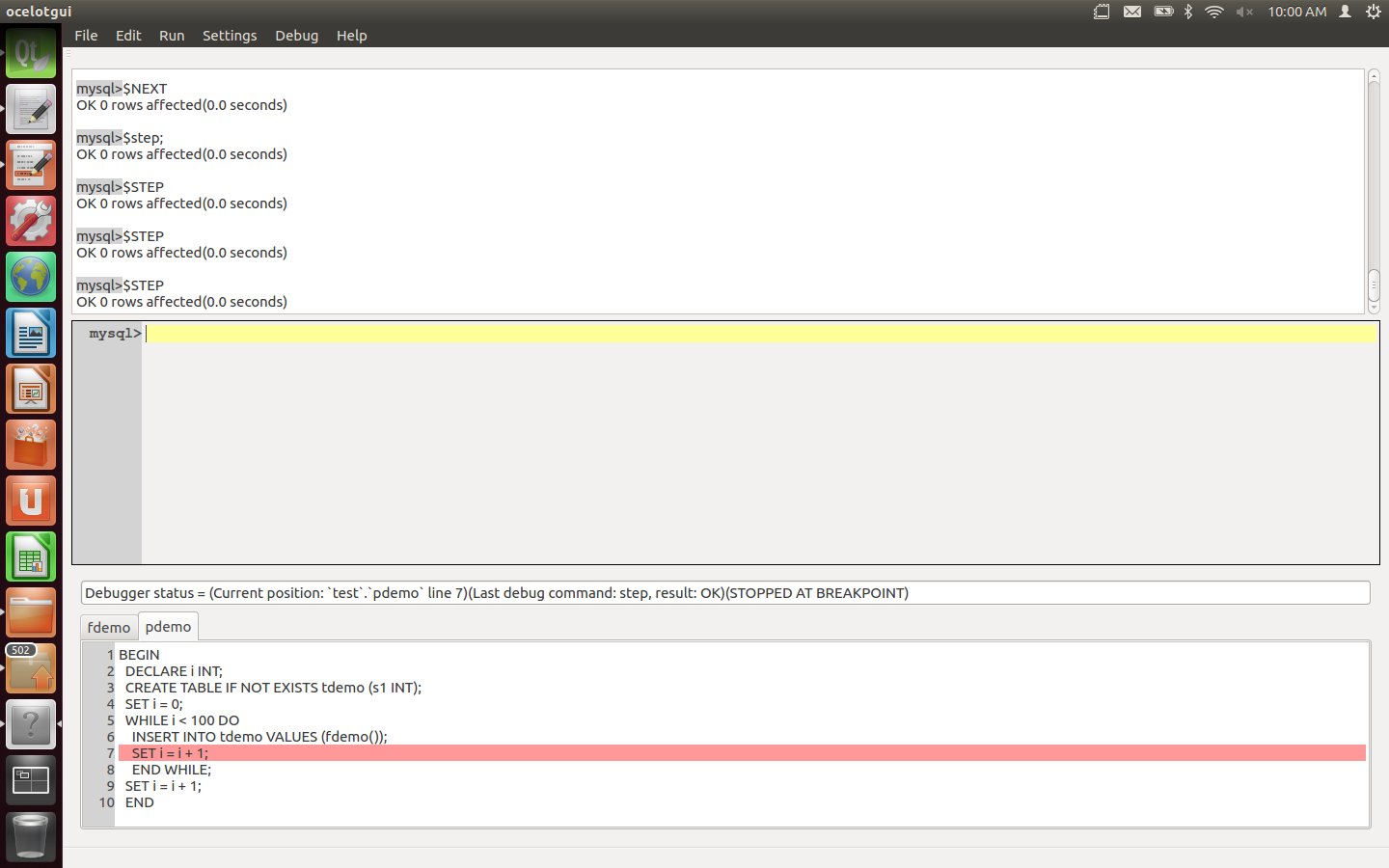
Set a breakpoint for the final executable line of the procedure. This can be done by clicking over the line number, or by moving the cursor to the line and then clicking Debug|Breakpoint, or by typing the statement "$breakpoint pdemo 9;". After this is executed, line 9 of pdemo has a small red mark showing that it has a breakpoint.
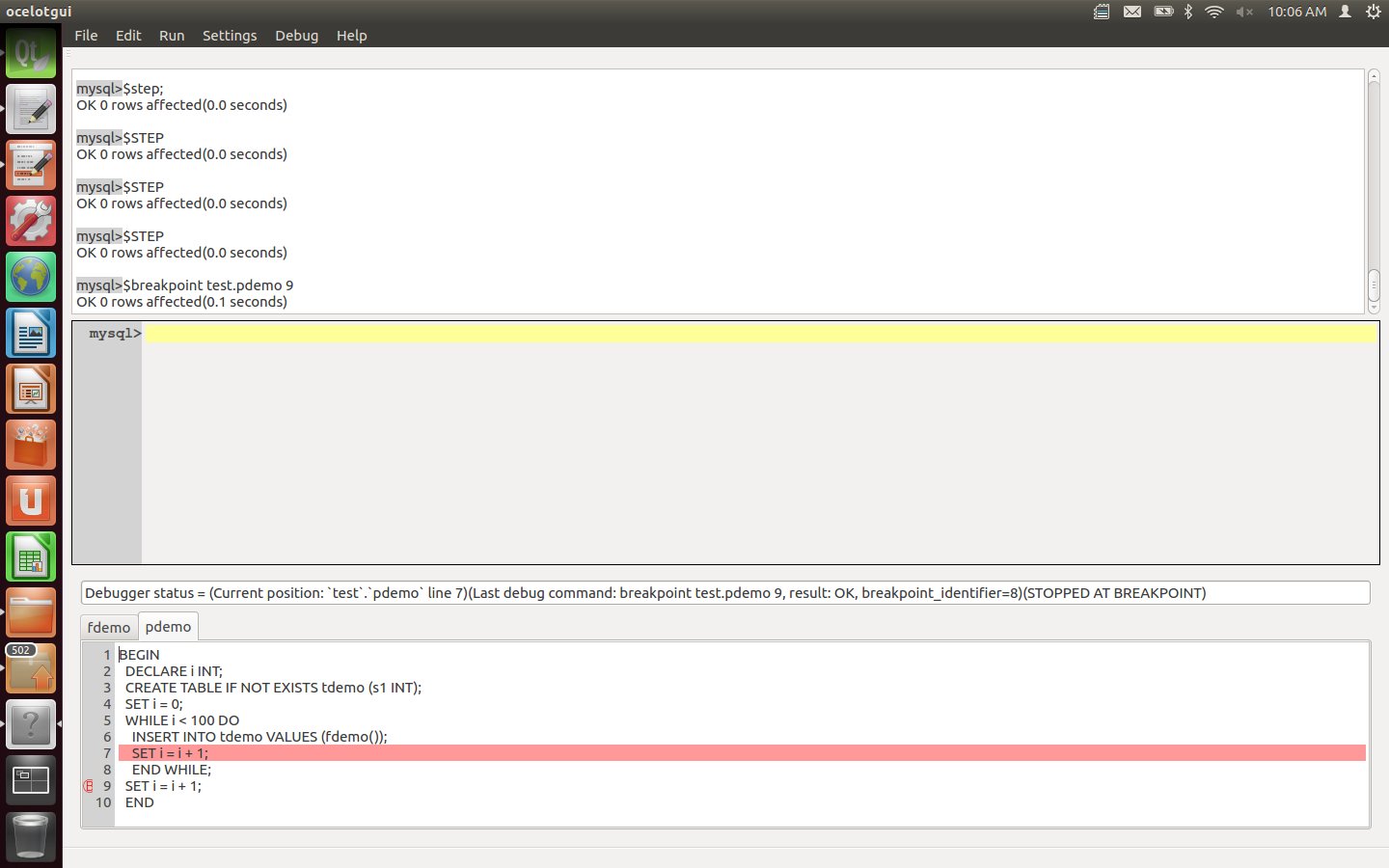
Enter a Continue instruction. After this is executed, watch the debugger highlight hop around 100 times as it moves through the loop, and finally settle on line 9.
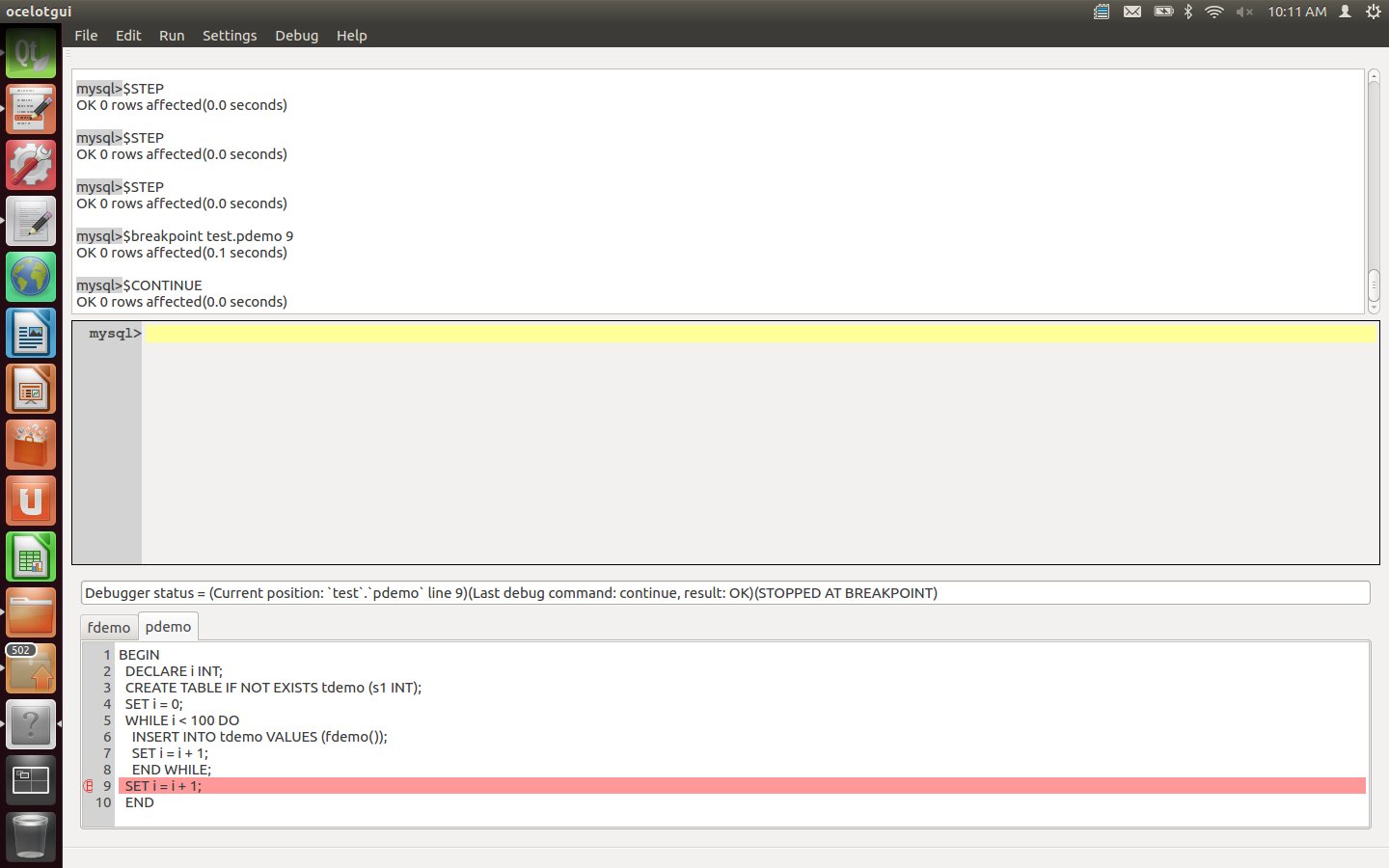
Type the statements "$refresh variables;" and "select old_value, value from xxxmdbug.variables;". After this is executed, the result-set widget will contain the old value of variable i (99) and the current value (100), This is the way that one examines DECLAREd variables (there are other statements for user variables and server variables).
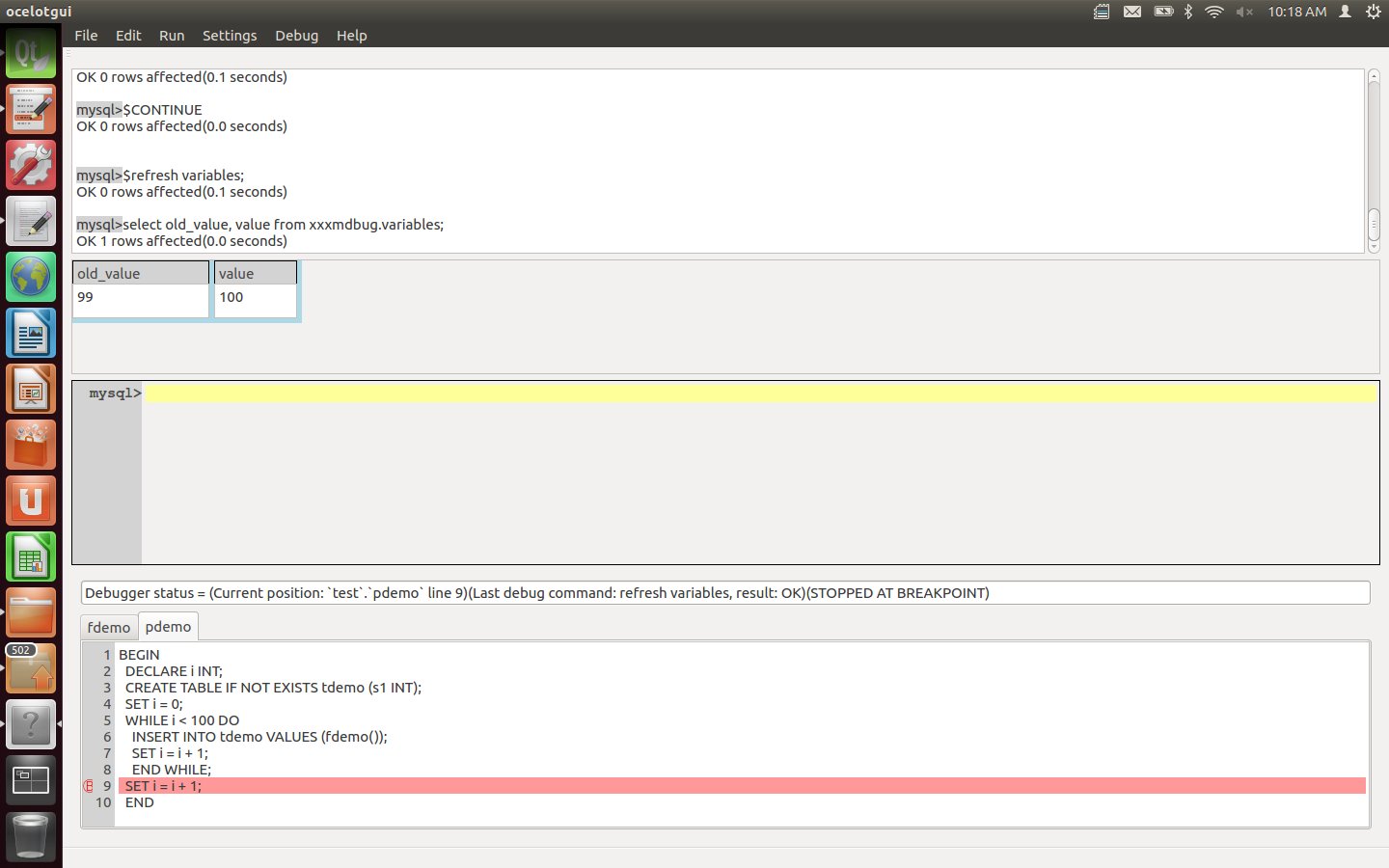
Enter an $exit instruction. This stops the debugging session, so the effects of the earlier $debug instruction are cancelled. The effects of the earlier $install and $setup instructions are not cancelled, so they will not have to be repeated for the next debugging session involving pdemo and fdemo.
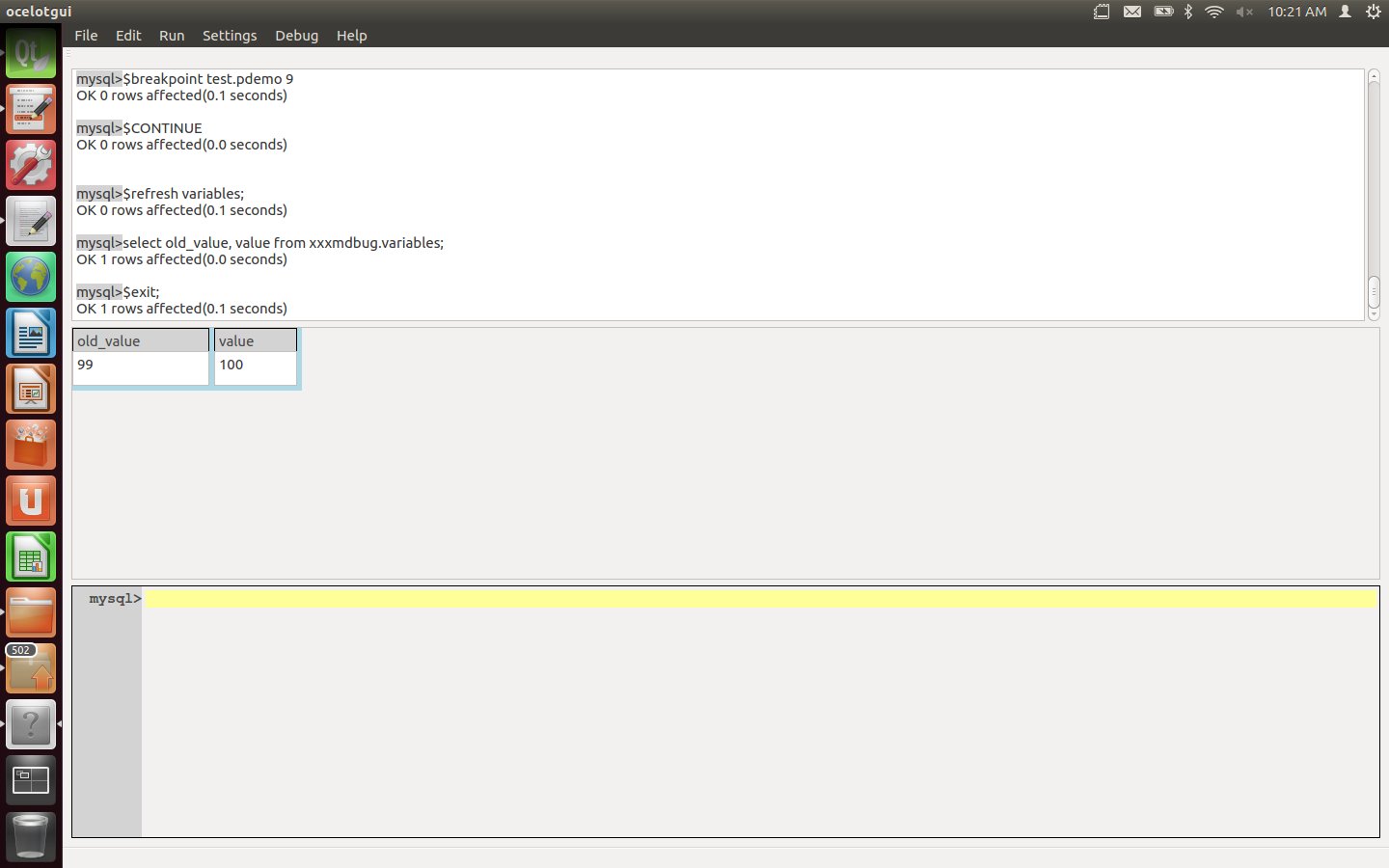
Thus ends our demo. If you would like to confirm it: an introduction for how ocelotgui in general works is in the earlier blog post An open-source MySQL/MariaDB client on Linux" and the source + executable download files for version 0.3.0 are on github.com/ocelot-inc/ocelotgui.
If there is anything Ocelot can do to make your next debugging trip more enjoyable, please leave a comment. If you have private thoughts, please write to pgulutzan at ocelot.ca.
Stored Procedures: critiques and defences
I’ve gathered the main critiques of MySQL / MariaDB stored procedures, and will try some defences.
Monoglots
The critique:
SQL/PSM is the standard 4GL and it was the work of Andrew Eisenberg. Andy based it on ADA. Unless you are military, you have never seen ADA. Be grateful it is dead.
— Joe Celko, reminiscing about his days on the SQL standard committee
Actually I believe Mr Celko likes SQL/PSM, which is the standard that MySQL and MariaDB follow. Here at last is your chance to see some Ada code, and compare with MySQL code …
Ada |
MySQL |
|---|---|
declare a: integer;
begin
a := 0;
loop
a := a + 100;
exit when a = 200;
end loop;
if a /= 300 then
a := 400;
else
a := 500;
end if;
case a is
when 600 a := 700;
when others a := 800;
end case;
end;
|
begin
declare a integer;
set a = 0;
x:loop
set a = a + 100;
if a = 200 then leave x; end if;
end loop;
if a <> 300 then
set a = 400;
else
set a = 500;
end if;
case a
when 600 then set a = 700;
else set a = 800;
end case;
end;
|
The trouble is, Ada isn’t even among the top ten programming languages according to O’Reilly’s count of book sales, and the choice of only 1.6% of programmers according to the Language Popularity Index. So programmers aren’t used to seeing syntax like the above. And I, who am just as good a psychologist as I am an Ada programmer, explain: they’re not familiar with it, so they call it ugly.
The defence:
Look at the first alternative: UDFs. Percona posts point out that UDFs can be faster. of course.
But look at the example in Managing & Using MySQL Second Edition. Do you understand it without reading the long commentary?
Now look at the second alternative: External stored procedures. There’s a worklog task for stored procedures in other languages, of course.
But it’s moribund. An implementation on launchpad, “External Language Stored Procedures for MySQL”, exists but doesn’t seem to have been updated since 2009. Are you going to go to the trouble of downloading and adjusting it?
If you answered yes to either of the above questions, please check the length of your nose now.
Migrants
The critique:
“Migrating a stored procedure is much more complex than rewriting one because the relevant standards of various vendors differ greatly. In this situation, users have no choice but stick to one database vendor rigidly. There is not any room left for users to beat down the price if database vendors overcharge them on upgrading their servers, storages, and user license agreements.”
— Couchbase, “Alternative to Difficult Stored Procedures in Big Data Computation”
The defence: That’s not true. There’s only one relevant standard, there are multiple migration paths, and there’s no charge.
The other DBMSs that follow the ANSI/ISO SQL/PSM standard are: DB2, Mimer, SolidDB, Sybase iAnywhere (Advantage Database Server).
Selective quotes from a case study about “experiences with porting stored procedures written in SQL PL (DB2) to MySQL”:
To find out how “standardized” the MySQL implementation of the SQL/PSM specification really is, we tried to port all our DB2 stored procedures to MySQL. First, we ran into DB2 non-standard extensions of SQL PL that were used in our existing procedures. Actually, there was only one such extension [SQLCODE] … So we first rewrote our DB2 procedures –in DB2–, making sure not to use SQLCODE anymore. Instead we had to introduce the corresponding continue handler(s), thereby introducing an additional “flag” variable. This worked out fine: the new procedures ran perfectly in DB2. … Now we observed some syntactic differences, luckily not in the body of the procedures but in the optional clauses specified just before the body … The only option clause which we could keep was the “LANGUAGE SQL”: required in DB2, optional with MySQL. After these small modifications, the CREATE PROCEDURE statements from DB2 worked on MySQL!
But did they run properly? To verify this, we had to create identical tables on both systems, have the same test data in both, and migrate then run the unit test programs from DB2 on MySQL. And indeed: it turned out that MySQL worked exactly as expected!
— Peter Vanroose (ABIS), MySQL: stored procedures and SQL/PSM
As for Oracle, its PL/SQL language is not standard, but read the Oracle documentation: “PL/SQL is based on the programming language Ada.” Due to the common Ada heritage that PL/SQL and SQL/PSM share, I’ve been able to convert Oracle stored procedures to MySQL stored procedures at a rate of about a line per minute. I expect I’d achieve the same speed with NuoDB (NuoDB architect Jim Starkey once assured me that their stored procedures will follow PL/SQL), and with PostgreSQL (PostgreSQL’s stored procedures are deliberately Oracle-like). There’s also an SQL/PSM add-on for PostgreSQL, although I don’t think it’s popular.
Finally, there are some commercial tools that try to automate the migration process. I think the one from ispirer is the best known.
Toolmakers
The critique:
Your stored routines are not likely to integrate well with your IDE. … [SQL-oriented GUI tools] do not integrate (well?) with your source control … While engineers are keen on writing unit tests for every class and method they create, they are less keen on doing the same for stored routines. … MySQL routines have [no?] built in debugging capabilities …
— Shlomi Noach, “Why delegating code to MySQL Stored Routines is poor engineering practice”
The defence:
These are important considerations, but strictly speaking they’re about what people should have written to go with stored procedures, not about stored procedures themselves. It’s not the wiener’s fault if there’s no mustard.
Take versioning. For Oracle it can be done with a client GUI named Oracle SQL Developer. For MySQL there are open-source utilities like dbv. Either way, it’s not a server task.
Take unit tests. Hmm, okay, you can’t, but some people might be satisfied with MyTAP or maybe even STK/Unit. And did you notice in the quote above that one can make unit tests with DB2 tools and run them in MySQL?
Take debuggers. I’m aware of five, although I haven’t tried any of them, except the one that I wrote myself. I am going to integrate it with ocelotgui.
Could-do-betters
The critique:
Stored Procedures … do not perform very well
— Percona employee, How can we bring query to the data”
The defence:
Supposedly there are more than 12 million installations and that means there are 12 million which are, as the old saying goes, “not Facebook”. I haven’t interviewed them all (only Monty Widenius can do that), but the ones that I’ve talked to are concerned more about the effects of badly-written queries or database design mistakes.
Grapevines
The critique:
It’s easy to find articles and blog posts with titles like “Why I hate stored procedures”, “Goodbye Stored procedures, It’s the time to move on”, “Stored Procedures – End of days”, “Why I avoid stored procedures and you should too”.
The defence:
Usually those articles are about SQL Server. They are by people who got fed up with Microsoft’s T-SQL language, or got enamoured of ORM (Object Relational Management). Inevitably some of the bad vibes get picked up in the MySQL / MariaDB community due to morphic resonance. Filter out the Microsoft material, and it gets harder to find such articles or blog posts, and it gets easier to find articles with more walking-in-the-sunshine outlook.
Besides, some of the alternatives might just be fads. As Winston Churchill said:
Many forms of Database Code have been tried, and will be tried in this world of sin and woe. No one pretends that Stored Procedures are perfect or all-wise. Indeed, it has been said that Stored Procedures are the worst form of Database Code except all those other forms that have been tried from time to time.
— Winston Churchill, Hansard, November 11 1947
Okay, he didn’t actually say Database Code or Stored Procedures, he said Government and Democracy. Close enough.
Sloths
The critique:
“The following features have been added to MySQL 5.6: … GET DIAGNOSTICS”
“The following features have been added to MySQL 5.7: … GET STACKED DIAGNOSTICS”
— MySQL user manual for 5.6 and 5.7
All right, you have to read between the lines a bit to see the critique here.
What MySQL/Oracle is implying, by omission, is: progress is glacial. As I said in a previous post I think GET DIAGNOSTICS is good to see. But the first MySQL 5.6 releases were four years ago. So, one significant new feature every two years.
What about MariaDB? Well, I did see a new trick recently in a blog post by Federico Razzoli: How MariaDB makes Stored Procedures usable, about using cursors even for SHOW statements. And I suppose that MariaDB’s “compound statements” feature could be looked on as at least a feature that’s closely related to stored procedures. Still, small potatoes.
The defence:
* The current implementation has pretty well all the significant matters required by the standard.
* There has been no official announcement that any significant stored procedure feature is deprecated.
GET DIAGNOSTICS
I know of seven DBMSs that support GET DIAGNOSTICS: DB2, Oracle Rdb, MySQL, MariaDB, PostgreSQL, Teradata, Mimer.
I regret that its clauses don’t resemble SELECT’s clauses and that the result isn’t a table, but it’s always good to see standard compliance.
Now GET DIAGNOSTICS is getting better due to two new features, one in MySQL and the other in MariaDB.
STACKED
The problem: suppose a condition (an error or warning) happens. Execution goes to a condition handler (a series of statements that are preceded by DECLARE … CONDITION HANDLER FOR condition-value). Now, within those statements, how do we know what was the condition that caused the execution to go to the handler?
For example:
CREATE PROCEDURE p ()
BEGIN
DECLARE CONTINUE HANDLER FOR SQLWARNING
BEGIN
statement-1;
statement-2;
statement-3;
END;
SIGNAL SQLSTATE '01000';
END
Well, the answer looks easy: if you say GET DIAGNOSTICS before statement-1, you’ll get ‘01000’. But there are no guarantees after that, so you’d have to store the results of GET DIAGNOSTICS somewhere, in case you need to see them later.
The solution: GET STACKED DIAGNOSTICS, a new feature in MySQL 5.7. There are now two diagnostics areas: diagnostics area #1 = the “current” one, and diagnostics area #2 = the “stacked” one. The stacked diagnostics area always has the results as they were upon entry. Here’s an illustration:
delimiter //
CREATE PROCEDURE p ()
BEGIN
DECLARE CONTINUE HANDLER FOR SQLEXCEPTION BEGIN
SIGNAL SQLSTATE '01000';
GET CURRENT DIAGNOSTICS CONDITION 1 @current = RETURNED_SQLSTATE;
GET STACKED DIAGNOSTICS CONDITION 1 @stacked = RETURNED_SQLSTATE;
END;
SIGNAL SQLSTATE '03000';
END//
CALL p()//
SELECT @current, @stacked//
The result: @current = ‘01000’ but @stacked =’03000′. There’s been a known bug since February, but that’s okay in an unreleased version.
Multiple warnings
The problem: if there are two warnings, you want to see both of them with GET DIAGNOSTICS. This is especially desirable because SHOW WARNINGS has no trouble returning a set of warnings, and it would be great if we could eliminate SHOW WARNINGS usage (for reasons unrelated to this problem). However, we don’t know in advance that there will be two warnings, and we don’t have a direct way to check. If we put the check for warnings in a procedure, then that works with MariaDB but requires a privilege. If we ask for conditions that don’t exist, then a curious error/warning hybrid happens, which is workaroundable but confusing.
The solution: dynamic compound statements, a new feature in MariaDB 10.1. I mentioned it last week but didn’t think: hmm, if there’s no reason that the diagnostics area would be cleared by a simple comparison. So can I put GET DIAGNOSTICS statements inside an IF … THEN … ELSE so that I get zero, or one, or two results just by typing in appropriately on the mysql client?
I’ll start by creating a table and doing an INSERT, with default SQL mode, in MariaDB only, will cause two “Division by 0” warnings. Then I’ll see what the new feature does.
DELIMITER //
CREATE TABLE test (s1 INT)//
INSERT INTO test VALUES ('a'),('a')//
GET DIAGNOSTICS @condition_count = number//
IF @condition_count = 1 THEN
GET DIAGNOSTICS CONDITION 1 @message_1 = message_text;
SELECT @message_1;
ELSEIF @condition_count = 2 THEN
GET DIAGNOSTICS CONDITION 1 @message_1 = message_text;
GET DIAGNOSTICS CONDITION 2 @message_2 = message_text;
SELECT @message_1, @message_2;
END IF//
The result: both warnings are displayed. Whoopee.
By the way
The worklog task for GET DIAGNOSTICS was WL#2111 Stored Procedures: Implement GET DIAGNOSTICS. Since it got implemented long ago, it’s obsolete. But if you’re interested “what happens if GET DIAGNOSTICS itself causes an error?” and the reasons behind our decisions at that time, go over there and click the high level architecture box.
Temporary tables, standard SQL
The PostgreSQL manual says:
“The standard’s definition of the behavior of temporary tables is widely ignored. PostgreSQL’s behavior on this point is similar to that of several other SQL databases.”
The first sentence is false. The second sentence could be rephrased as “MySQL copied us”, although nobody else did, as far as I know.
The standard’s definition is widely followed
I base this claim on the documentation of DB2, Oracle Rdb, Oracle 12c, and Firebird.
I don’t say the standard is “universally followed” — for example SQL Server is out of step. I don’t say the whole standard is followed — only the subset related to global temporary tables. I don’t say the standard is the only thing that’s followed. But all these DBMSs support at least four, and sometimes all six, of these characteristics:
1. There is a syntax CREATE GLOBAL TEMPORARY TABLE <table-name> … The word GLOBAL means “the scope of the name is global”, that is, it’s recognized by all modules. Since most DBMSs don’t have multiple modules, the word GLOBAL is compulsory and the standard’s other type of temporary table, LOCAL, is usually not there. (I will mention, though, parenthetically, that LOCAL could optionally mean a temporary table is local to a stored procedure if it’s created in a stored procedure.)
2. If there is a non-temporary table already existing with the same name, then CREATE GLOBAL TEMPORARY TABLE fails.
3. There’s a distinction between the metadata — the definition of the table — and the data — the contents of the table.
4. The metadata is persistent; the data disappears when the session ends, or earlier.
5. The metadata is visible to all sessions in INFORMATION_SCHEMA or equivalent. The data is not visible to all sessions, and one sometimes calls the temporary table’s contents “session-specific data”.
6. There is an optional clause ON COMMIT {PRESERVE|DELETE} ROWS. When ON COMMIT DELETE ROWS is specified or is default, then the data disappears when COMMIT happens.
PostgreSQL’s behaviour is copied by MySQL
For PostgreSQL, the CREATE TEMPORARY TABLE statement arrived in PostgreSQL 6.5 which was released in June 1999. For MySQL, CREATE TEMPORARY TABLE arrived in MySQL 3.23 in August 1999.
That was before my time, but I’m a post-hoc-ergo-propter-hoc kind of guy, and I suspect that somebody was seduced by the logical fallacy that PostgreSQL has some standard SQL, therefore copy it. So the thing that’s presently in MySQL and MariaDB is CREATE TEMPORARY TABLE table_name …;
But these DBMSs support zero (0) of the six characteristics that I described for the standard-compliant DBMSs.
1. The specification of scope is missing.
2. If there is a non-temporary table already existing with the same name, then CREATE TEMPORARY TABLE succeeds, and the existing table is hidden.
3. There’s no distinction between the metadata — the definition of the table — and the data — the contents of the table.
4. The metadata is not persistent; the data disappears when the session ends, or earlier.
5. The metadata is not visible to all sessions in INFORMATION_SCHEMA or equivalent … Yes, I’m refusing to acknowledge the existence of the new table INNODB_TEMP_TABLE_INFO, for quality reasons.
6. There is no optional clause ON COMMIT {PRESERVE|DELETE} ROWS.
One funny result of this is that simple statements like SELECT * FROM table_name; can’t be fully checked or optimized at the time they’re checked within a stored procedure, because there’s no way to know what table_name is — maybe at execution time it will be the table that’s defined and visible in information_schema, but maybe it will be a temporary table which is only temporarily visible.
A less serious but irritating result is that, if you want to use a temporary table repeatedly, you have to re-create everything — find the original table definition somewhere, then add whatever indexes or views or triggers applied originally.
Is there any good news?
I wrote a worklog task about this long ago. It was WL#934 “Temporary tables in the standard way”. But it is a private Oracle spec, and is not in the Internet archive, so the general public can’t see it. There’s been no action on it that I know of. Some attention has been paid to feature request #58392 “Prevent TEMPORARY tables from shadowing regular tables” and feature request #20001 “Support for temp-tables in INFORMATION_SCHEMA”, but those are mere distractions.
However, it remains possible to implement standard global temporary tables without disrupting existing applications. The key is the syntax difference between
CREATE TEMPORARY TABLE ...; /* MySQL or MariaDB */
and
CREATE GLOBAL TEMPORARY TABLE ...; /* standard */
They’re two different statements. So one could just say that “if and only if GLOBAL is specified, then the table has to have the standard rules”.
This isn’t due to luck. It happened because in olden days MySQL’s architects paid attention to the official ANSI/ISO framework requirements:
“In the Syntax Rules, the word shall defines conditions that are required to be true of syntactically-conforming SQL language … The treatment of language that does not conform to the SQL Formats and Syntax Rules is implementation-dependent.”
In other words, by allowing only the non-standard syntax CREATE TEMPORARY TABLE, MySQL is not violating the standard. On the other hand, the latest PostgreSQL release allows CREATE GLOBAL TEMPORARY TABLE, so PostgreSQL is violating the standard. To people who read my earlier blog post “Sometimes MySQL is more standards-compliant than PostgreSQL”, that won’t come as a shock.
An open-source MySQL/MariaDB GUI client on Linux
We’ve written a GUI application. Its command-line options are like those in the mysql client. Its graphic features are an SQL-statement text editor and a scrollable SQL result set. It runs on Linux now and we believe it could be ported to other platforms.
Here are four screenshots.
The startup is as non-GUI as can be — in fact it gets options from the command line, or from my.cnf, the same way that the mysql client does. Wherever it seemed reasonable, we asked: What would mysql do?
The statement (at the bottom of the screenshot) has the usual GUI features for editing, and has syntax highlighting — comments are green, reserved words are magenta, and so on.
Here the result is appearing in a grid. The second column is long so it’s on multiple lines with its own scroll bars.
Finally, here’s the same result after fooling around with cosmetics — the colours and fonts for each section of the screen are resettable via menu items, and the column widths can be changed by dragging.
The program is written in C++ and uses Qt. Qt is available on many operating systems including Mac and Windows but we only tried Linux. The license is GPL version 2. The status is alpha — there are bugs. Source and executable files can be downloaded from https://github.com/ocelot-inc/ocelotgui.
The BINARY and VARBINARY data types
MySQL’s support of the BINARY and VARBINARY data type is good, and the BINARY and VARBINARY data types are good things. And now the details. What applies here for MySQL applies for MariaDB as well.
Who supports VARBINARY
There’s an SQL:2008 standard optional feature T021 “BINARY and VARBINARY data types”. Our book has a bigger description, but here is one that is more up to date:
| DBMS | Standard-ish? | Maximum length |
|---|---|---|
| DB2 for LUW | No. Try CHAR FOR BIT DATA. | 254 for fixed-length, 32672 for variable-length |
| DB2 for z/OS | Yes. | 255 for fixed-length, 32704 for variable-length |
| Informix | No. Try CHAR. | 32767 |
| MySQL | Yes. | constrained by maximum row length = 65535 |
| Oracle | No. Try RAW. | 2000 sometimes; 32767 sometimes |
| PostgreSQL | No. Try BYTEA. | theoretically 2**32 – 1 |
| SQL Server | Yes. | 8000 for fixed-length. 2**31 -1 for variable length |
Standard Conformance
Provided that sql_mode=strict_all_tables, MySQL does the right (standard) thing most of the time, with two slight exceptions and one exception that isn’t there.
The first exception:
CREATE TABLE t1 (s1 VARBINARY(2)); INSERT INTO t1 VALUES (X'010200');
… This causes an error. MySQL is non-conformant. If one tries to store three bytes into a two-byte target, but the third byte is X’00’, there should be no error.
The second exception:
SET sql_mode='traditional,pipes_as_concat'; CREATE TABLE t2 (s1 VARBINARY(50000)); CREATE TABLE t3 AS SELECT s1 || s1 FROM t2;
… This does not cause an error. MySQL is non-conformant. If a concatenation results in a value that’s longer than the maximum length of VARBINARY, which is less than 65535, then there should be an error.
The exception that isn’t there:
The MySQL manual makes an odd claim that, for certain cases when there’s a UNIQUE index, “For example, if a table contains ‘a’, an attempt to store ‘a\0’ causes a duplicate-key error.” Ignore the manual. Attempting to insert ‘a\0’ will only cause a duplicate-key error if the table’s unique-key column contains ‘a\0’.
The poem Antigonish desccribed a similar case:
Yesterday, upon the stair,
I met a man who wasn’t there.
He wasn’t there again today,
I wish, I wish he’d go away…”
The BINARY trap
Since BINARY columns are fixed-length, there has to be a padding rule. For example, suppose somebody enters zero bytes into a BINARY(2) target:
CREATE TABLE t4 (s1 BINARY(2)); INSERT INTO t4 VALUES (X''); SELECT HEX(s1) FROM t4;
… The result is ‘0000’ — the padding byte for BINARY is X’00’ (0x00), not X’20’ (space).
There also has to be a rule about what to do for comparisons if comparands end with padding bytes.
CREATE TABLE t5 (s1 VARBINARY(2)); INSERT INTO t5 VALUES (X'0102'); SELECT * FROM t5 WHERE s1 = X'010200';
… This returns zero rows. It’s implementation-defined whether MySQL should
ignore trailing X’00’ during comparisons, so there was no chance of getting
it wrong.
The behaviour difference between BINARY and VARBINARY can cause fun:
CREATE TABLE t7 (s1 VARBINARY(2) PRIMARY KEY); CREATE TABLE t8 (s1 BINARY(2), FOREIGN KEY (s1) REFERENCES t7 (s1)); INSERT INTO t7 VALUES (0x01); INSERT INTO t8 SELECT s1 FROM t7;
… which fails on a foreign-key constraint error! It looks bizarre
that a value which is coming from the primary-key row can’t be put
in the foreign-key row, doesn’t it? But the zero-padding rule, combined
with the no-ignore-zero rule, means this is inevitable.
BINARY(x) is a fine data type whenever it’s certain that all the values
will be exactly x bytes long, and otherwise it’s a troublemaker.
When to use VARBINARY
VARBINARY is better than TINYBLOB or MEDIUMBLOB because it has a definite
maximum size, and that makes life easier for client programs that want to
know: how wide can the display be? In most DBMSs it’s more important that BLOBs can be stored separately from the rest of the row.
VARBINARY is better than VARCHAR if there should be no validity checking.
For example, if the default character set is UTF8 then this is illegal:
CREATE TABLE t9 (s1 VARCHAR(5)); INSERT INTO t9 VALUES (0xF4808283);
… but this is legal because character set doesn’t matter:
CREATE TABLE t10 (s1 VARBINARY(5)); INSERT INTO t10 VALUES (0xF4808283);
(I ran into this example on a SQL Server forum where the participants display woeful ignorance of Unicode).
And finally converting everything to VARBINARY is one way to avoid the annoying message “Invalid mix of collations”. In fact the wikimedia folks appear to have changed all VARCHARs to VARBINARYs back in 2011 just to avoid that error. I opine that the less drastic solution is to use collations consistently, but I wasn’t there.
